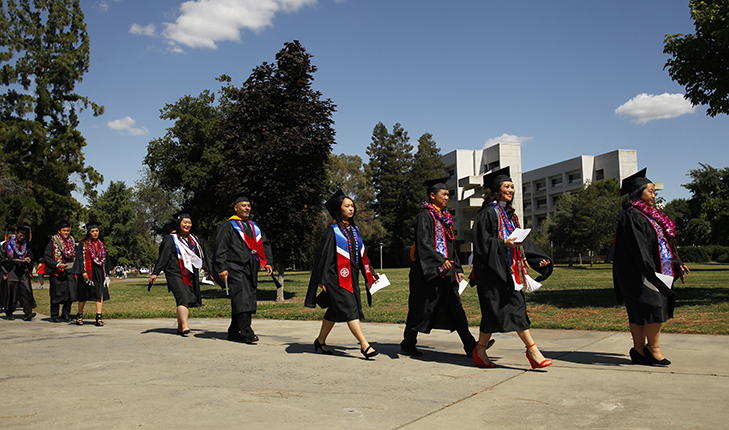Hmong American students at Fresno State enter the University with higher-than-average GPAs and do well comparable to other students once on campus, but they face unique challenges that become a barrier to graduation, a new University report shows.
Hmong students have more household and family responsibilities, language issues and struggle to make campus connections to aid in their success, the report said.
“There isn’t a ton of research on their unique experiences. Culture plays such a huge part in our students’ daily lives,” said Alex Nottbohm, a research analyst in Fresno State’s Office of Institutional Effectiveness who co-authored the report with criminology professor Dr. Yoshiko Takahashi.
“They experience challenges more intensely than some of our other students and that really has an impact on anyone’s ability for academic success,” Nottbohm said.
The report, “The Role of Institutional Data: A Focus on Hmong American Student Success,” takes a closer look at the Hmong student experience, analyzes the barriers Hmong students face and starts a conversation around how the University can support their needs.
Fresno, and the greater San Joaquin Valley, is home to one of the largest Hmong populations in the country with 23,449 living in the city, according to the U.S. Census. The Hmong were recruited by the United States Special Forces and Central Intelligence Agency to fight alongside American soldiers during the Vietnam War. The Hmong fled their homes in southeast Asia when the war ended and were resettled in the U.S., primarily in California and Minnesota.
In fall 2018, there were 1,444 Hmong students enrolled at Fresno State. They make up about 6% of the University’s undergraduate student population, one of the largest proportions in the California State University system. Many are the first in their families to go to college with about 85 percent of students reporting that neither parent earned a college degree.
But only 3% of the full-time Hmong students who enter as first-time freshmen graduate within four years of starting at Fresno State compared to 15% of other students who do. By year six, 40% of those Hmong students have graduated compared to 57% of other students. A higher percentage of Hmong students leave the University without earning a degree than others, the report said.
“Academically, Hmong students are performing very similarly to students of other ethnicities, but there’s still a gap in graduation rates for the two groups,” Nottbohm said. “So, what can the University do to better support our Hmong students?“
Nottbohm and Takahashi began their research two years ago through the Office of Institutional Effectiveness’ Faculty Fellows Program that looked to enhance collaborative research to address questions of importance to the University. The study included an analysis of institutional data and a survey of Hmong students compared to a similar group of students with the same socioeconomic and academic backgrounds who were not Hmong.
Their findings show that Hmong students experience typical student challenges like difficulty studying and avoiding procrastination and course access, but also have distinct challenges such as juggling family and household responsibilities, having reservations about reaching out to faculty for help and language barriers.
One student surveyed said, “I have used many resources on campus and most of the time I have trouble using them because of comfort … I’m always asking myself do they know what I’m going through as a Hmong student? Do they know my Hmong background? Do they really understand me?”
Hmong students are also less certain about their academic progress than other students. At least 73% surveyed said they were not confident about graduating in four years compared with 56% of the control group surveyed. More were certain about graduating in six years with 74% of the Hmong respondents replying “yes” to feeling confident — but that’s still below the confidence level of other students, 92% of whom replied they were confident.
There are differences among male and female students, too, with Hmong male students reporting they have difficulty adjusting to the social and cultural climate of the University and that they work to pay for school. Hmong women report spending more time caring for family and doing chores.
Takahashi said she has gained insight to her Hmong students since starting her research. Criminology was identified in the report as the most popular major among Hmong men. Hmong students, in general, tend to be shy and quiet in class, she said. The report survey found Hmong men are more likely to attend class if they know someone else in class.
That discovery changed Takahashi’s teaching. “I started creating more small group discussions or group projects to try to connect the Hmong students,” Takahashi said. “It’s understanding the data, which is helping me to develop a strategy of how to teach in the classroom.”
The report serves as a guide to help start conversations and establish best practices to help support students for success.
The report is available on the Office of Institutional Effectiveness website.





